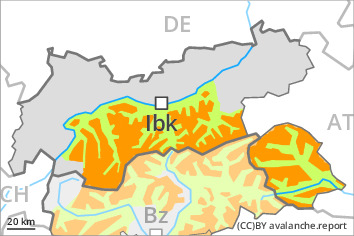
Danger level
 | 2000m |
|  |
|  | ||||
|  |
|  |

Distinct weak layers in the old snowpack necessitate defensive route selection. Fresh wind slabs require caution.
Single winter sport participants can release avalanches easily.
Remotely triggered and natural avalanches are possible in isolated cases, in the regions exposed to a lot of wind especially in the regions with a lot of snow as well as.
Mostly the avalanches are small. On wind-loaded slopes medium-sized avalanches are possible.
The avalanche prone locations are to be found in all aspects above approximately 2000 m. Caution is to be exercised in gullies and bowls, and behind abrupt changes in the terrain, as well as adjacent to ridgelines in all aspects. In the regions of the south exposed to the foehn wind the avalanche prone locations are more prevalent, also below the tree line.
Whumpfing sounds and the formation of shooting cracks when stepping on the snowpack and fresh avalanches serve as an alarm indicating the danger. The avalanche prone locations are currently prevalent immediately adjacent to the pistes as well.
Snowpack
dp.1: deep persistent weak layer
dp.6: cold, loose snow and wind
The old snowpack will be unstable over a wide area. Stability tests and field observations confirm the unfavourable bonding of the snowpack.
In some regions 5 to 15 cm of snow, and even more in some localities, has fallen. In particular in the northeast 5 to 10 cm of snow, and even more in some localities, will fall on Sunday. The new snow is lying on surface hoar in some places. As a consequence of a moderate to strong northerly wind, easily released wind slabs will form.
A little snow is lying.
Tendency
Wind slabs and weakly bonded old snow represent the main danger.




